Sudden Variation Effect of Aerodynamic Loads and Safety Analysis of Running Trains When Entering Tunnel Under Crosswind
Abstract
Featured Application
Abstract
1. Introduction
2. Wind–Train–Track Coupling Dynamic Model
2.1. Modelling of Train
2.2. Modelling of Track
3. Simulation of Aerodynamic Loads
3.1. Governing Equations for Fluids
3.2. Aerodynamic Loads
4. Numerical Demonstration
4.1. Scenario Prototype
4.2. Solving Process
4.3. Verification
4.3.1. Verification of Calculation Scheme
4.3.2. Verification of Boundary Condition
4.3.3. Analysis of Mesh Sensitivity
4.3.4. Verification of Aerodynamic Pressure
5. Aerodynamic Loads and Safety Analysis
5.1. Flow Structure and Aerodynamic Loads
5.2. Safety Analysis
5.2.1. Derailment Coefficient
5.2.2. Wheel Load Reduction Rate
5.2.3. Safety Criteria
6. Conclusions
- (a)
- When a train enters tunnels with crosswind, the difference of flow field and pressure between inside and outside the tunnel causes sudden a variation in the five aerodynamic load components, with respect to time, at the same instance. The five aerodynamic load components contribute to the safety risk of the running train.
- (b)
- The global maximum of DCs and WRR of trains is likely to be achieved during tunnel entry with crosswind than in a crosswind environment due to the sudden disappearance of wind excitation when other conditions remain the same.
- (c)
- The safety risk of the head carriage is higher than that of the rear carriage and even more than the middle carriage because of the transient aerodynamic effect on the head and rear carriages at the tunnel entrance. This finding is consistent with the actual situation of the rollover accident of a running train that occurred in Xinjiang, China in 2007.
Author Contributions
Funding
Acknowledgments
Conflicts of Interest
References
- Cheli, F.; Corradi, R.; Sabbioni, E.; Tomasini, G. Wind tunnel tests on heavy road vehicles: Cross wind induced loads-Part 1. J. Wind Eng. Ind. Aerodyn. 2011, 99, 1000–1010. [Google Scholar] [CrossRef]
- Dorigatti, F.; Sterling, M.; Baker, C.J.; Quinn, A.D. Crosswind effects on the stability of a model passenger train– A comparison of static and moving experiments. J. Wind Eng. Ind. Aerodyn. 2015, 138, 36–51. [Google Scholar] [CrossRef]
- García, J.; Muñoz-paniagua, J.; Crespo, A. Numerical study of the aerodynamics of a full scale train under turbulent wind conditions, including surface roughness effects. J. Fluids Struct. 2017, 74, 1–18. [Google Scholar] [CrossRef]
- Krajnović, S.; Ringqvist, P.; Nakade, K.; Basara, B. Large eddy simulation of the flow around a simplified train moving through a crosswind flow. J. Wind Eng. Ind. Aerodyn. 2012, 110, 86–99. [Google Scholar] [CrossRef]
- Giappino, S.; Rocchi, D.; Schito, P.; Tomasini, G. Cross wind and rollover risk on lightweight railway vehicles. J. Wind Eng. Ind. Aerodyn. 2016, 153, 106–112. [Google Scholar] [CrossRef]
- Suzuki, M.; Tanemoto, K.; Maeda, T. Aerodynamic characteristics of train/vehicles under cross winds. J. Wind Eng. Ind. Aerodyn. 2003, 91, 209–218. [Google Scholar] [CrossRef]
- Bocciolone, M.; Cheli, F.; Corradi, R.; Muggiasca, S.; Tomasini, G. Crosswind action on rail vehicles: Wind tunnel experimental analyses. J. Wind Eng. Ind. Aerodyn. 2008, 96, 584–610. [Google Scholar] [CrossRef]
- Deng, L.; Yan, W.C.; Nie, L. A simple corrosion fatigue design method for bridges considering the coupled corrosion-overloading effect. Eng. Struct. 2019, 178, 309–317. [Google Scholar] [CrossRef]
- Thomas, D.; Berg, M.; Stichel, S.; Diedrichs, B. Rail vehicle response to lateral carbody excitations imitating crosswind. Proc. Inst. Mech. Eng. Part F J. Rail Rapid Transit 2015, 229, 34–47. [Google Scholar] [CrossRef]
- Deng, E.; Yang, W.C.; Lei, M.F.; Zhu, Z.H.; Zhang, P.P. Aerodynamic loads and traffic safety of high-speed trains when passing through two windproof facilities under crosswind: A comparative study. Eng. Struct. 2019, 188, 320–339. [Google Scholar] [CrossRef]
- Wei, L.; Zeng, J.; Wu, P.B.; Song, C.Y. Safety analysis of high speed trains under cross winds using indirect wheel-rail force measuring method. J. Wind Eng. Ind. Aerodyn. 2018, 183, 55–67. [Google Scholar] [CrossRef]
- Yang, W.C.; Deng, E.; Lei, M.F.; Zhang, P.P.; Yin, R.S. Flow structure and aerodynamic behavior evolution during train entering tunnel with entrance in crosswind. J. Wind Eng. Ind. Aerodyn. 2018, 175, 229–243. [Google Scholar] [CrossRef]
- Yang, W.C.; Deng, E.; Lei, M.F.; Zhu, Z.H.; Zhang, P.P. Transient aerodynamic performance of high-speed trains when passing through two windproof facilities under crosswinds: A comparative study. Eng. Struct. 2019, 188, 729–744. [Google Scholar] [CrossRef]
- Yao, Z.Y.; Xiao, J.H.; Jiang, F.Q. Characteristics of daily extreme-wind gusts along the Lanxin Railwayin Xinjiang, China. Aeolian Res. 2012, 6, 31–40. (In Chinese) [Google Scholar] [CrossRef]
- Muñoz-paniagua, J.; García, J.; Crespo, A. Genetically aerodynamic optimization of the nose shape of a high-speed train entering a tunnel. J. Wind Eng. Ind. Aerodyn. 2014, 130, 48–61. [Google Scholar] [CrossRef]
- Raffaele, V.; Ferrand, V.; Da Silva, A.; Le Moyne, L. Forces and flow structures evolution on a car body in a sudden crosswind. J. Wind Eng. Ind. Aerodyn. 2014, 128, 114–125. [Google Scholar]
- Deng, E.; Yang, W.C.; Yi, R.S.; Zhang, P.P. Study on the transient aerodynamic performance of high-speed train running into tunnel under crosswind. J. Hunan Univ. Nat. Sci. 2019, 46, 69–78. (In Chinese) [Google Scholar]
- Deng, E.; Yang, W.C.; Zhang, P.P. Impact effect of aerodynamic load on high speed train entering tunnel under crosswind. J. South China Univ. Technol. Nat. Sci. Ed. 2019, 47, 130–138. (In Chinese) [Google Scholar]
- Krajnović, S. Numerical simulation of the flow around an ICE2 train under the influence of a wind gust. In Proceedings of the International Conference on Railway Engineering 2008 (IET ICRE 2008), Challenges for Railway Transportation in Information Age, Hong Kong, China, 25–28 March 2008. [Google Scholar]
- Baker, C. The flow around high speed trains. J. Wind Eng. Ind. Aerodyn. 2010, 98, 277–298. [Google Scholar] [CrossRef]
- Flynn, D.; Hemida, H.; Soper, D.; Baker, C. Detached-eddy simulation of the slipstream of an operational freight train. J. Wind Eng. Ind. Aerodyn. 2014, 132, 1–12. [Google Scholar] [CrossRef]
- García, J.; Muñoz-paniagua, J.; Jiménez, A.; Migoya, E.; Crespo, A. Numerical study of the influence of synthetic turbulent inflow conditions on the aerodynamics of a train. J. Fluids Struct. 2015, 56, 134–151. [Google Scholar] [CrossRef]
- Hemida, H.; Baker, C.; Gao, G. The calculation of train slipstreams using large-eddy simulation. Proc. Inst. Mech. Eng. Part F J. Rail Rapid Transit 2014, 228, 25–36. [Google Scholar] [CrossRef]
- Muñoz-paniagua, J.; García, J. Aerodynamic surrogate-based optimization of the nose shape of a high-speed train for crosswind and passing-by scenarios. J. Wind Eng. Ind. Aerodyn. 2019, 184, 139–152. [Google Scholar] [CrossRef]
- Deng, E.; Yang, W.C.; Deng, L.; Zhu, Z.H.; He, X.H.; Wang, A. Time-resolved aerodynamic loads on high-speed trains during running on a tunnel-bridge-tunnel infrastructure under crosswind. Eng. Appl. Comput. Fluid Mech. 2020, 14, 202–221. [Google Scholar] [CrossRef]
- BS EN 14067-6: 2018 BSI Standards Publication Railway Applications–Aerodynamics; BSI: Brussels, Belgium, 2018.
- Diedrichs, B.; Ekequist, M.; Stichel, S.; Tengstrand, H. Part F: Journal of Rail and Rapid Transit Quasi-static modelling of wheel–rail reactions due to crosswind effects for various types of high-speed rolling stock. Proc. Inst. Mech. Eng. 2004, 218, 133–148. [Google Scholar] [CrossRef]
- Cai, C.S.; Chen, S.R. Framework of vehicle-bridge-wind dynamic analysis. J. Wind Eng. Ind. Aerodyn. 2004, 92, 579–607. [Google Scholar] [CrossRef]
- Zhou, Y.F.; Chen, S.R. Fully coupled driving safety analysis of moving traffic on long-span bridges subjected to crosswind. J. Wind Eng. Ind. Aerodyn. 2015, 143, 1–18. [Google Scholar] [CrossRef]
- Zhou, Y.F.; Chen, S.R. Vehicle ride comfort analysis with whole-body vibration on long-span bridges subjected to crosswind. J. Wind Eng. Ind. Aerodyn. 2016, 155, 126–140. [Google Scholar] [CrossRef]
- Zhu, Z.H.; Gong, W.; Wang, L.D.; Li, Q.; Bai, Y.; Yu, Z.; Harik, I.E. An efficient multi-time-step method for train-track-bridge interaction. Comput. Struct. 2018, 196, 36–48. [Google Scholar] [CrossRef]
- Zhu, Z.H.; Gong, W.; Wang, L.D.; Harik, I.E.; Bai, Y. A hybrid solution for studying vibrations of coupled train–track–bridge system. Adv. Struct. Eng. 2017, 20, 1699–1711. [Google Scholar] [CrossRef]
- Chu, C.R.; Chien, S.Y.; Wang, C.Y.; Wu, T.R. Numerical simulation of two trains intersecting in a tunnel. Tunn. Undergr. Sp. Technol. 2014, 42, 161–174. [Google Scholar] [CrossRef]
- Jeong, U.Y.; Koh, H.M.; Lee, H.S. Finite element formulation for the analysis of turbulent wind flow passing bluff structures using the RNG k-ε model. J. Wind Eng. Ind. Aerodyn. 2002, 90, 151–169. [Google Scholar] [CrossRef]
- Kim, J.J.; Baik, J.J. A numerical study of the effects of ambient wind direction on flow and dispersion in urban street canyons using the RNG k-ε turbulence model. Atmos. Environ. 2004, 38, 3039–3048. [Google Scholar] [CrossRef]
- Han, K.; Tian, H.Q. Research and application of testing technology of aerodynamics at train-tunnel entry on special passenger railway lines. J. Cent. South Univ. Sci. Technol. 2007, 38, 326–332. (In Chinese) [Google Scholar]
- Wan, X.Y.; Wu, J. In-situ test and study on the aerodynamic effect of the rolling stock passing through tunnels with a speed of 200 km/h. Mod. Tunn. Technol 2006, 143, 43–48. (In Chinese) [Google Scholar]
- Ministry of Railways of the, P.R.C. TB/T 2360-1993. Identification Method and Evaluation Standard for Dynamic Performance Test of Railway Locomotive; China Railway (Beijing) Culture Media Co., LTD.: Beijing, China, 1993. [Google Scholar]
- Standardization Administration of, P.R.C. GB5599-1985. Railway Trains–Specification for Evaluation the Dynamic Performance and Accreditation Test; Standards Press of China: Beijing, China, 1985. [Google Scholar]
- National Railway Administration of the P.R.C. TB/T 3352-2014. PSD of Ballastless Track Irregularities of High-Speed Railway; Standards Press of China: Beijing, China, 2014. [Google Scholar]
- Zhai, W.M.; Xia, H. Train-Track-Bridge Dynamic Interaction: Theory and Engineering Application; China Science publishing & Media Ltd.: Beijing, China, 2011. [Google Scholar]
- TG/03-2009. Railway Passenger Line Technical Management Measures; China Railway Publishing House: Beijing, China, 2009; (Part: 200–250 km/h).
- TG/04-2009. Railway Passenger Line Technical Management Measures; China Railway Publishing House: Beijing, China, 2009; (Part: 300–350 km/h).
- Olmos, J.M.; Astiz, M. Improvement of the lateral dynamic response of a high pier viaduct under turbulent wind during the high-speed train travel. Eng. Struct. 2018, 165, 368–385. [Google Scholar] [CrossRef]



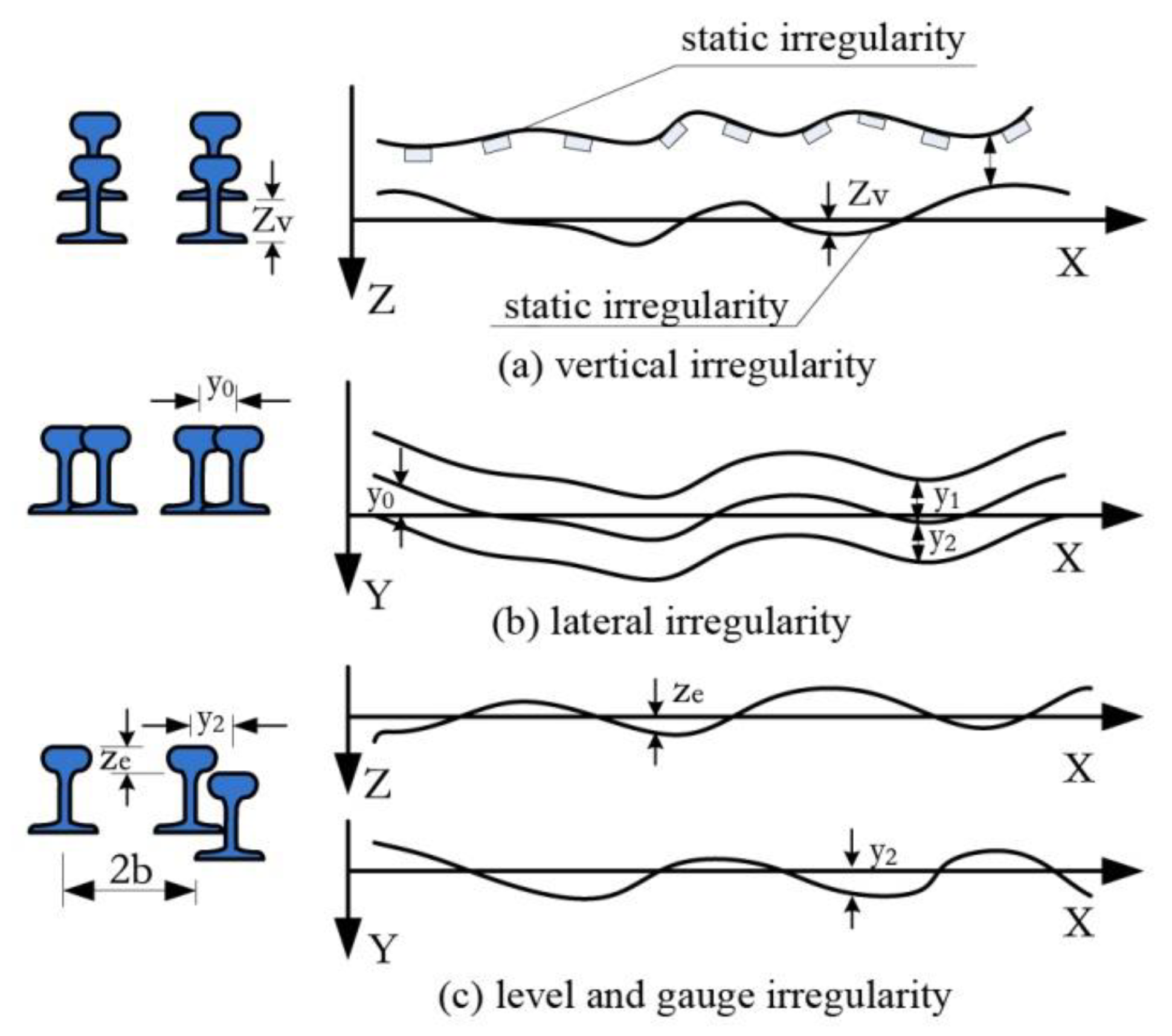







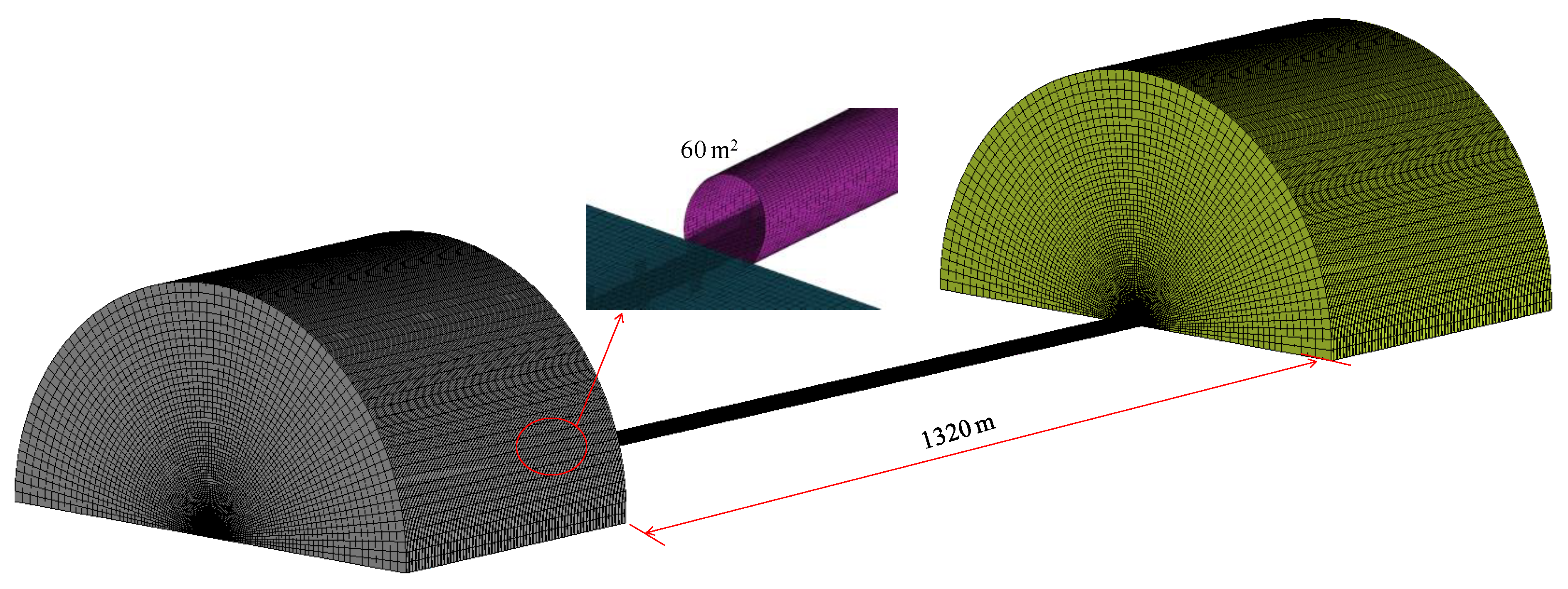




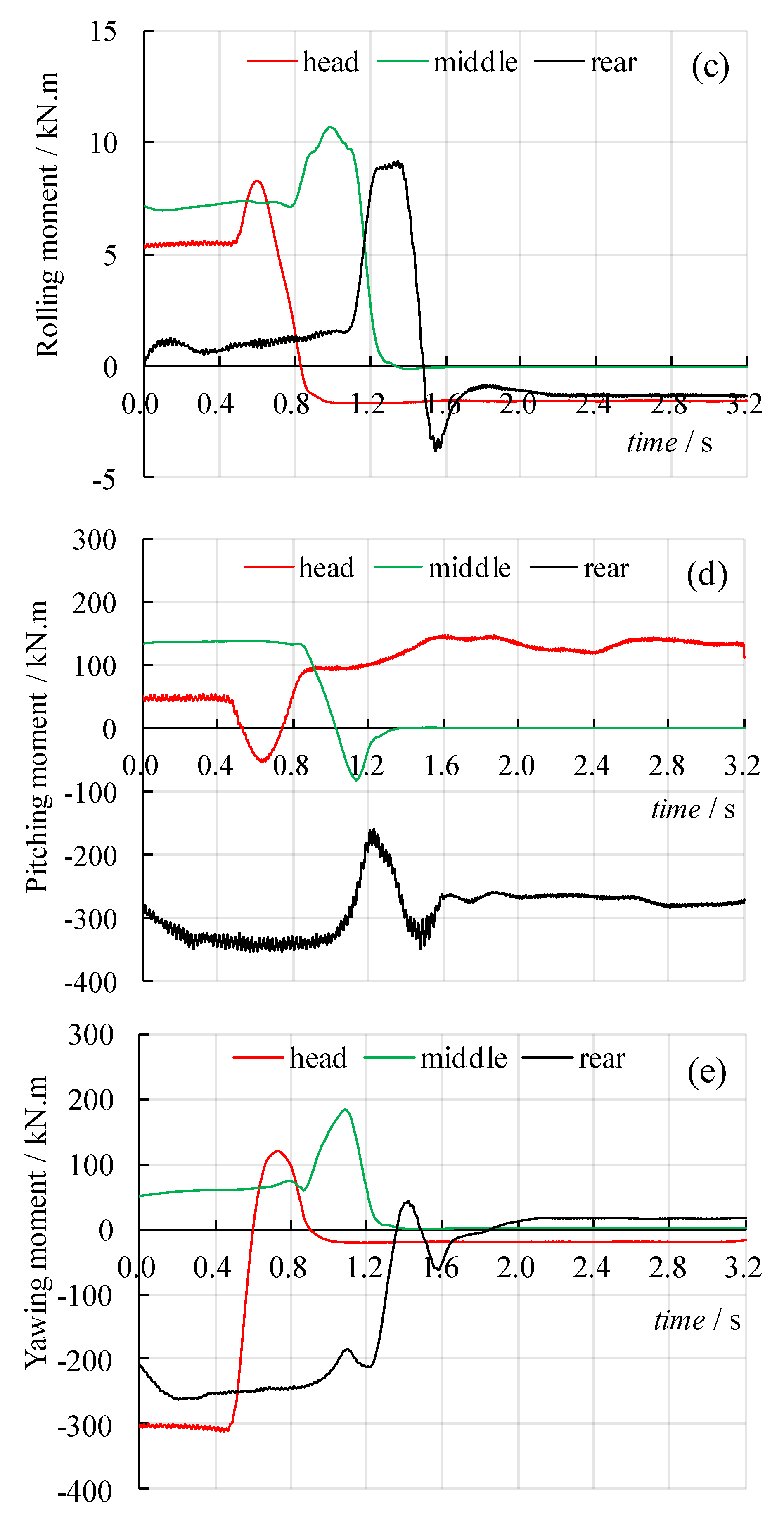
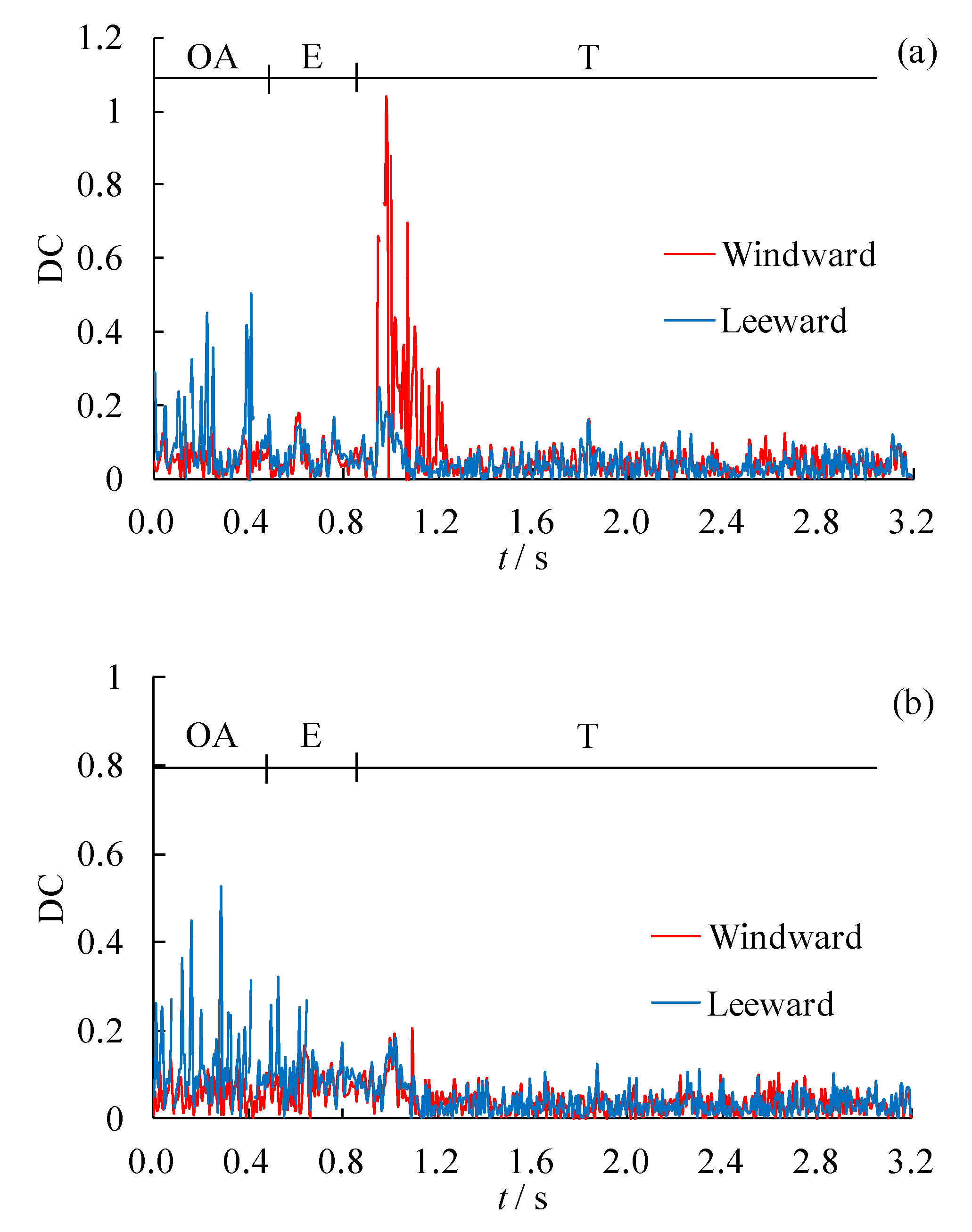







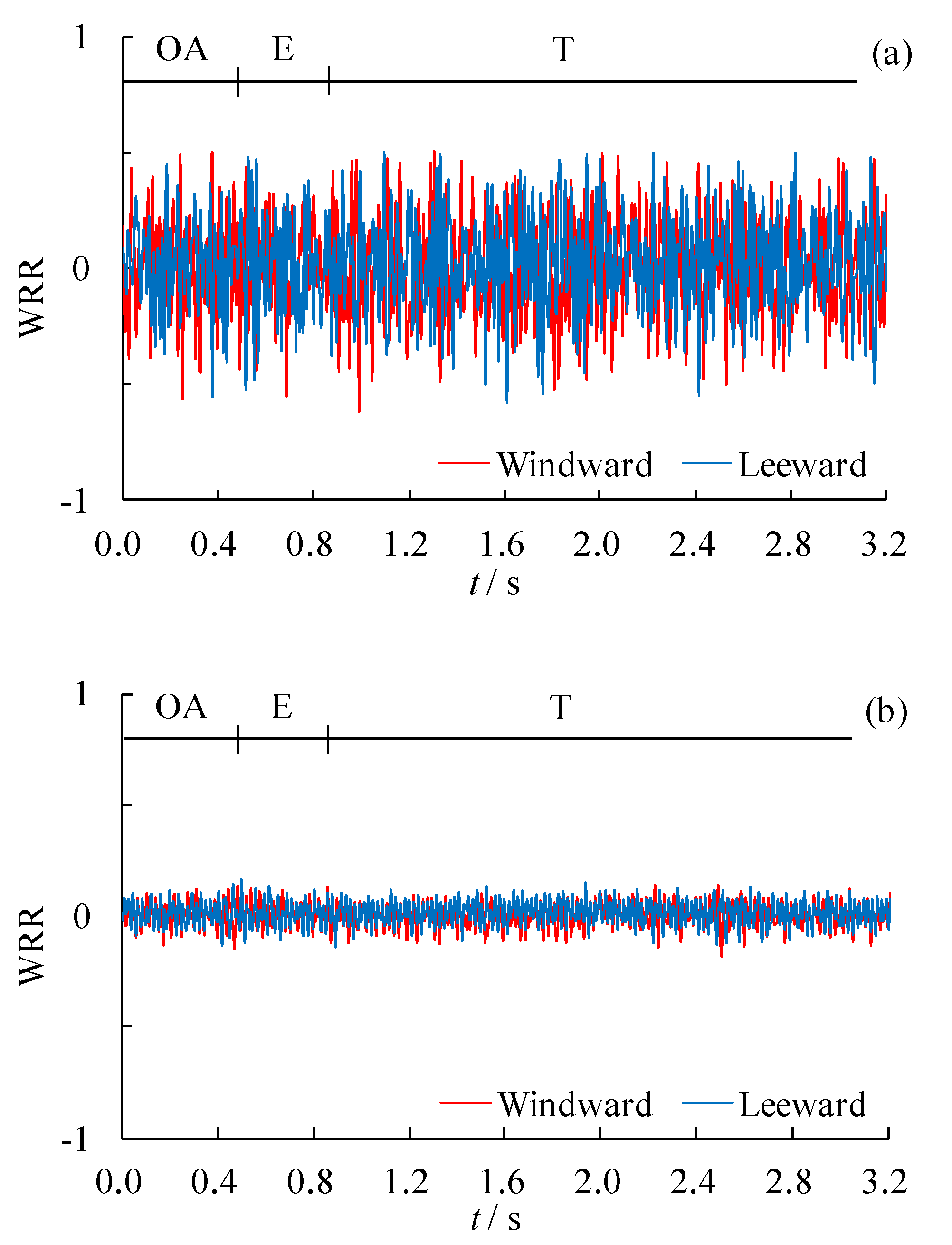


| Notation | Value | Unit | |
|---|---|---|---|
| Head (or Rear) Carriage | Middle Carriage | ||
| 3.96 × 104 | 3.44 × 104 | kg | |
| 1.015 × 105 | 7.4 × 104 | kg·m2 | |
| 2.74 × 106 | 2.74 × 106 | kg·m2 | |
| 1.0644 × 106 | 2.74 × 106 | kg·m2 | |
| 3.2 × 103 | 2.6 × 103 | kg | |
| 3.2 × 103 | 1.6 × 103 | kg·m2 | |
| 8.6 × 103 | 1.7 × 103 | kg·m2 | |
| 7.2 × 103 | 1.7 × 103 | kg·m2 | |
| 2.4 × 103 | 2.4 × 103 | kg | |
| 1.2 × 103 | 1.2 × 103 | kg·m2 | |
| 1.2 × 103 | 1.2 × 103 | kg·m2 | |
| 9 × 103 | kN/m | ||
| 1.04 × 103 | kN/m | ||
| 3 × 103 | kN/m | ||
| 2.4 × 102 | kN/m | ||
| 4 × 102 | kN/m | ||
| 2.4 × 102 | kN/m | ||
| 5 | kN.s/m | ||
| 10 | kN.s/m | ||
| 5 | kN.s/m | ||
| 10 | kN.s/m | ||
| 10 | kN.s/m | ||
| 30 | kN.s/m | ||
| 0.95 | m | ||
| 1 | m | ||
| 1.25 | m | ||
| 8.75 | m | ||
| 0.14 | m | ||
| 0.14 | m | ||
| 0.64 | m | ||
| Safety Grade | Superior | Good | Qualified |
|---|---|---|---|
| DC | ≤0.6 | ≤0.8 | ≤0.9 |
© 2020 by the authors. Licensee MDPI, Basel, Switzerland. This article is an open access article distributed under the terms and conditions of the Creative Commons Attribution (CC BY) license (http://creativecommons.org/licenses/by/4.0/).
Share and Cite
Yang, W.; Deng, E.; Zhu, Z.; Lei, M.; Shi, C.; He, H. Sudden Variation Effect of Aerodynamic Loads and Safety Analysis of Running Trains When Entering Tunnel Under Crosswind. Appl. Sci. 2020, 10, 1445. https://doi.org/10.3390/app10041445
Yang W, Deng E, Zhu Z, Lei M, Shi C, He H. Sudden Variation Effect of Aerodynamic Loads and Safety Analysis of Running Trains When Entering Tunnel Under Crosswind. Applied Sciences. 2020; 10(4):1445. https://doi.org/10.3390/app10041445
Chicago/Turabian StyleYang, Weichao, E Deng, Zhihui Zhu, Mingfeng Lei, Chenghua Shi, and Hong He. 2020. "Sudden Variation Effect of Aerodynamic Loads and Safety Analysis of Running Trains When Entering Tunnel Under Crosswind" Applied Sciences 10, no. 4: 1445. https://doi.org/10.3390/app10041445
APA StyleYang, W., Deng, E., Zhu, Z., Lei, M., Shi, C., & He, H. (2020). Sudden Variation Effect of Aerodynamic Loads and Safety Analysis of Running Trains When Entering Tunnel Under Crosswind. Applied Sciences, 10(4), 1445. https://doi.org/10.3390/app10041445






